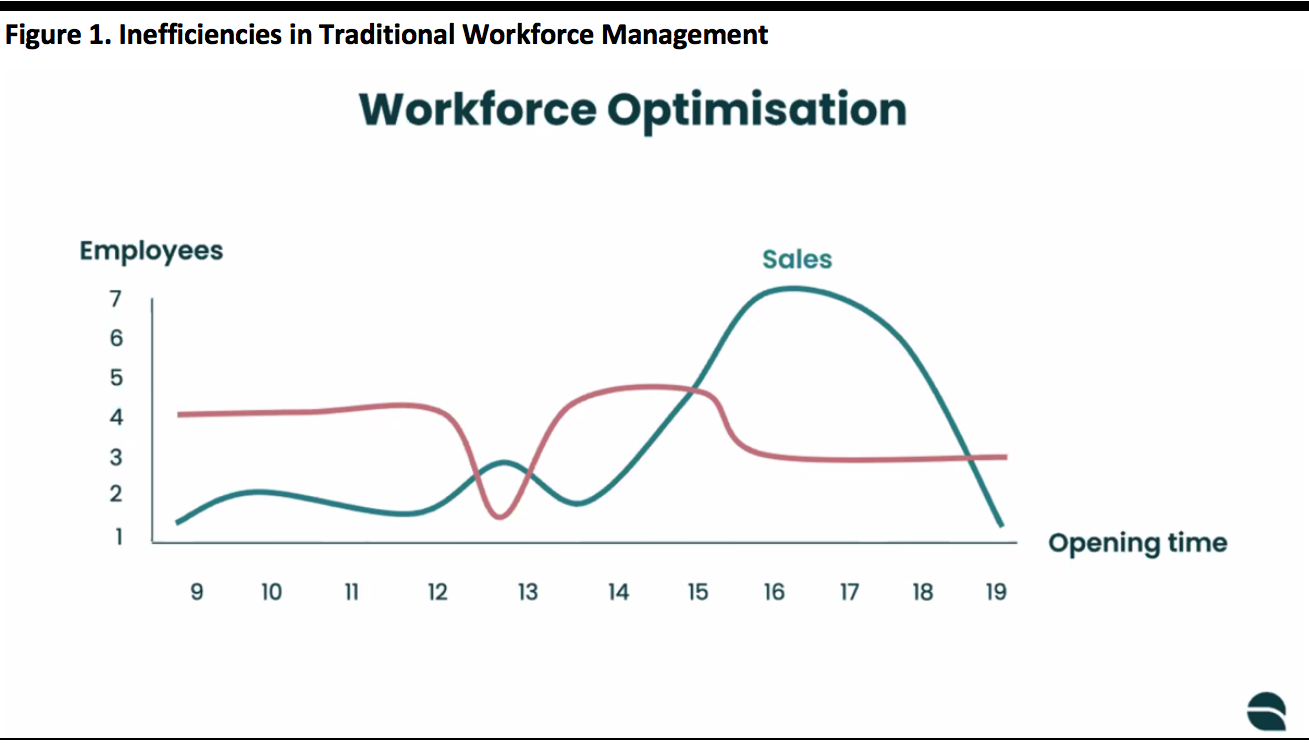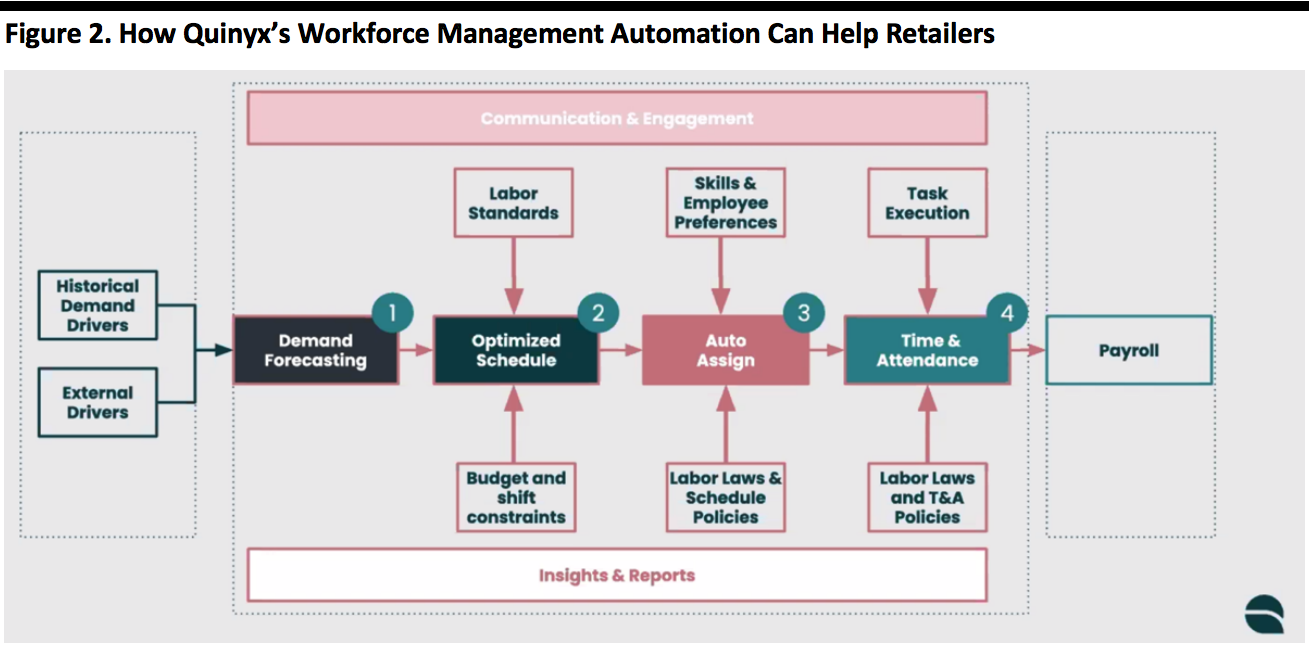
Nitheesh NH
We present key insights from a Coresight Research webinar on September 22, 2020, in which Quinyx CRO and Cofounder Andreas Sjölund discussed how the shift toward working from home, the emphasis on safety in stores, and increasingly unpredictable store traffic has made it more vital now than ever to optimize workforce management. The webinar was hosted by Steven Winnick, Senior Analyst at Coresight Research.
Meeting Employees Demands on Flexibility Can Boost Employer Revenues and Loyalty
Sjölund emphasized that employee priorities have shifted dramatically. Today, according to surveys conducted by Quinyx, 25% of global workers report that they would prefer a flexible schedule over a pay raise. Workers who do not have flexible schedules appear to be increasingly dissatisfied with the arrangement—some 31% of global employees admit to leaving a job because of scheduling challenges. A full 47% of workers report that they worry that switching shifts could get them fired.
The Covid-19 pandemic has only accelerated this increased demand for flexibility. As workers increasingly have to navigate coronavirus restrictions, transportation difficulties, and childcare or home education, more and more employees would benefit from a well-planned and efficiently executed flexible scheduling strategy. Sjölund explained that something as simple as planning out schedules in advance and enabling flexibility and shift changing between employees can have a positive impact on employee satisfaction.
Despite these opportunities to improve worker-employer relations, many employees remain frustrated by their lack of control over scheduling—41% of global employees report that system restrictions prevented them from switching shifts with a coworker. Sjölund believes that Quinyx’s automated workforce capabilities can enable employers to better understand and cater to the changing preferences of their employees.
Safety and Appreciation in the Work Environment Are Key
It is no secret that the Covid-19 pandemic has led to a renewed focus on hygienic and sanitary practices in the workplace.Despite this, Sjölund discussed witnessing several pain points in this context as well as areas of opportunity for retailers to improve their own efficiency. Retailers continue to face challenges when implementing safety protocols across multiple locations and communicating these guidelines to employees. Sjölund said that doing so manually without the aid of a workforce management software such as Quinyx can be time consuming and less effective, especially during the pandemic where state regulations can vary and be difficult to navigate. Sjölund believes that retailers should also prepare in advance for potential future soft lockdowns to avoid the difficulties they encountered in closing and reopening the first time round.
[caption id="attachment_117020" align="aligncenter" width="700"] Steven Winnick and Andreas Sjölund discuss automated workforce management
Steven Winnick and Andreas Sjölund discuss automated workforce management
Source: Coresight Research[/caption] Sjölund noted that many workers, especially during the pandemic, have felt undervalued by their employers—64% of workers have considered quitting their job because they are unhappy with their work environment. Sjölund believes that improved communication with employees and the ability to offer more flexible scheduling options will be key to improving employee satisfaction. Boosting employee morale has tangible benefits—engaged workers are on average 40% more productive than their unengaged peers. Automated Workforce Management Systems: Getting the Right People in the Right Place at the Right Time Many retailers still have difficulty optimizing the arrangement of employee shifts to match customer traffic and sales. As shown by the figure below, traditional workforce management techniques often do not maximize the number of retail employees working in-store when demand is highest. [caption id="attachment_117021" align="aligncenter" width="700"] Source: Quinyx[/caption]
Quinyx’s workforce management automation systems can help employers to close the gap between demand and employee allocation. Its software takes in a wide variety of information, including historical demand drivers, external factors, budget, labor regulations and employee skill sets to improve the efficiency of employee allocation. This system not only cuts organizational costs for retailers, but also boosts revenues by improving customer service in stores. Quinyx’s model is shown in Figure 2 below.
[caption id="attachment_117022" align="aligncenter" width="700"]
Source: Quinyx[/caption]
Quinyx’s workforce management automation systems can help employers to close the gap between demand and employee allocation. Its software takes in a wide variety of information, including historical demand drivers, external factors, budget, labor regulations and employee skill sets to improve the efficiency of employee allocation. This system not only cuts organizational costs for retailers, but also boosts revenues by improving customer service in stores. Quinyx’s model is shown in Figure 2 below.
[caption id="attachment_117022" align="aligncenter" width="700"] Source: Quinyx[/caption]
Sjölund believes that automated workforce management solutions are especially vital now. Unprecedented changes in consumer behavior defy sales and management projections drawn only from historical data—it is now key to examine data from the previous weeks and months, not years and decades. Sjölund explained that Quinyx is designed to help retailers examine more recent data effectively and pivot quickly in these unprecedented times.
Source: Quinyx[/caption]
Sjölund believes that automated workforce management solutions are especially vital now. Unprecedented changes in consumer behavior defy sales and management projections drawn only from historical data—it is now key to examine data from the previous weeks and months, not years and decades. Sjölund explained that Quinyx is designed to help retailers examine more recent data effectively and pivot quickly in these unprecedented times.
 Steven Winnick and Andreas Sjölund discuss automated workforce management
Steven Winnick and Andreas Sjölund discuss automated workforce managementSource: Coresight Research[/caption] Sjölund noted that many workers, especially during the pandemic, have felt undervalued by their employers—64% of workers have considered quitting their job because they are unhappy with their work environment. Sjölund believes that improved communication with employees and the ability to offer more flexible scheduling options will be key to improving employee satisfaction. Boosting employee morale has tangible benefits—engaged workers are on average 40% more productive than their unengaged peers. Automated Workforce Management Systems: Getting the Right People in the Right Place at the Right Time Many retailers still have difficulty optimizing the arrangement of employee shifts to match customer traffic and sales. As shown by the figure below, traditional workforce management techniques often do not maximize the number of retail employees working in-store when demand is highest. [caption id="attachment_117021" align="aligncenter" width="700"]
 Source: Quinyx[/caption]
Quinyx’s workforce management automation systems can help employers to close the gap between demand and employee allocation. Its software takes in a wide variety of information, including historical demand drivers, external factors, budget, labor regulations and employee skill sets to improve the efficiency of employee allocation. This system not only cuts organizational costs for retailers, but also boosts revenues by improving customer service in stores. Quinyx’s model is shown in Figure 2 below.
[caption id="attachment_117022" align="aligncenter" width="700"]
Source: Quinyx[/caption]
Quinyx’s workforce management automation systems can help employers to close the gap between demand and employee allocation. Its software takes in a wide variety of information, including historical demand drivers, external factors, budget, labor regulations and employee skill sets to improve the efficiency of employee allocation. This system not only cuts organizational costs for retailers, but also boosts revenues by improving customer service in stores. Quinyx’s model is shown in Figure 2 below.
[caption id="attachment_117022" align="aligncenter" width="700"] Source: Quinyx[/caption]
Sjölund believes that automated workforce management solutions are especially vital now. Unprecedented changes in consumer behavior defy sales and management projections drawn only from historical data—it is now key to examine data from the previous weeks and months, not years and decades. Sjölund explained that Quinyx is designed to help retailers examine more recent data effectively and pivot quickly in these unprecedented times.
Source: Quinyx[/caption]
Sjölund believes that automated workforce management solutions are especially vital now. Unprecedented changes in consumer behavior defy sales and management projections drawn only from historical data—it is now key to examine data from the previous weeks and months, not years and decades. Sjölund explained that Quinyx is designed to help retailers examine more recent data effectively and pivot quickly in these unprecedented times.